The Samsung Galaxy S21 Ultra & S21 Review: The Near Perfect and The Different
by Andrei Frumusanu on February 22, 2021 12:00 PM EST- Posted in
- Smartphones
- Samsung
- Mobile
- Galaxy S21
- Galaxy S21 Ultra
Display Measurement
We’ve noted many times now that the displays of the S21 series are relatively special, although for different reasons depending on the model.
The S21 Ultra’s new panel uses a new hybrid oxide pack panel technology along with a new OLED emitter generation that allows it offer seamless fine-grained refresh rate switching along with getting extremely bright while being much more power efficient. The smaller S21 doesn’t have any of the new display technologies, it is lower resolution, but still has software based adaptive frequency features. I did note that at least in terms of hardware build quality, the smaller S21 does seem to have advantages over the S20 series when it comes to its lamination, as I am seeing better viewing angles, and the panel being better glued to the glass.
When it comes to colour accuracy, we find Samsung’s usual display modes, limited to a “Vivid” setting that’s more saturated in terms of the colours, and allows you to fine-tune colour temperature to your taste, and the “Natural” screen mode that tries to adhere to sRGB and Display P3 colour gamuts and features near 6500K whites.
We move on to the display calibration and fundamental display measurements of the Galaxy S21 Ultra and S21 screens. As always, we thank X-Rite and SpecraCal, as our measurements are performed with an X-Rite i1Pro 2 spectrophotometer, with the exception of black levels which are measured with an i1Display Pro colorimeter. Data is collected and examined using Portrait Display's CalMAN software.

When it comes to screen brightness, the Galaxy S21 isn’t all much different to the S20 series, although it does allow for brighter manual brightness up to 393 nits on our unit. Peak full screen whites are still at around 700 nits when in auto-brightness mode under bright ambient conditions.
The S21 Ultra’s brightness is beyond any other OLED display on the market right now. Manual brightness is still limited by Samsung to only 462 nits, however when in auto-brightness, it goes to a staggering 942 nits – almost beating the superbly bright RGBW LCD display of the LG G7.
If you’re looking for a device which does excellently under sunlight, then the S21 Ultra is definitely the right choice.
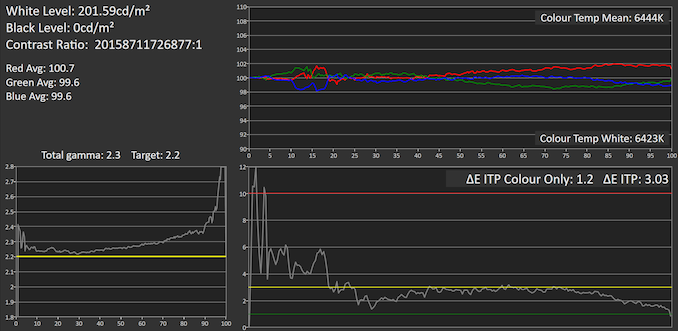
 Portrait Displays CalMAN
Portrait Displays CalMAN
Galaxy S21 Ultra
In terms of greyscale accuracy, the good news for this generation is that it seems Samsung has done a better job than in past years. Whites fall in at 6423K on the S21 Ultra, much less red than the S20 series devices’ calibration, with general great colour balance at dEITP of only 1.2. Gamma curve also looks reasonable although it’s still hard to measure this accurately due to Samsung’s APL brightness adjustments, even with fixed 50 APL and 50% windows sizes during out measurements.
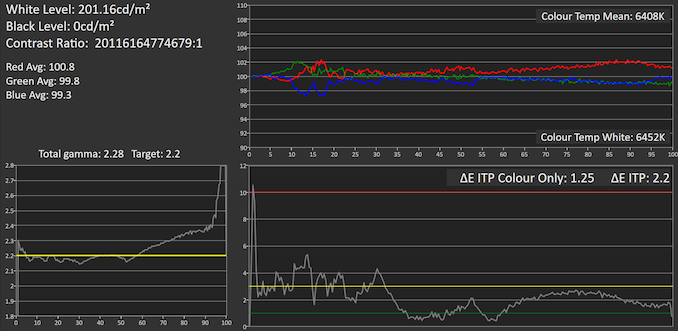
 Portrait Displays CalMAN
Portrait Displays CalMAN
Galaxy S21
The smaller Galaxy S21 also does very well, with great colour temperature out of the box .
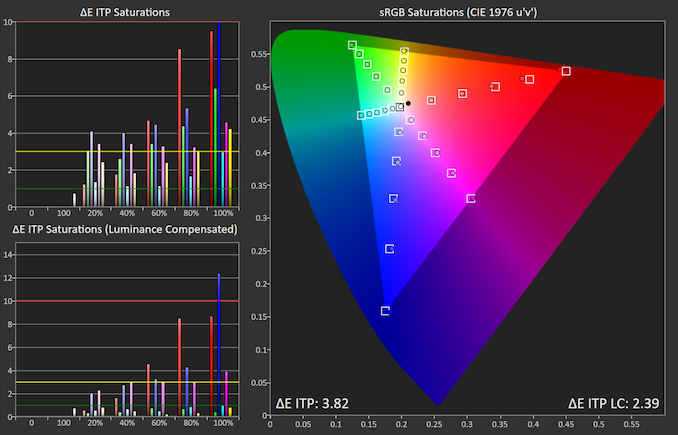 Portrait Displays CalMAN
Portrait Displays CalMAN
Galaxy S21 Ultra
Saturation accuracy on the S21 Ultra is great in all aspects except the reds, which for some reason are undersaturated at the maximum intensities.
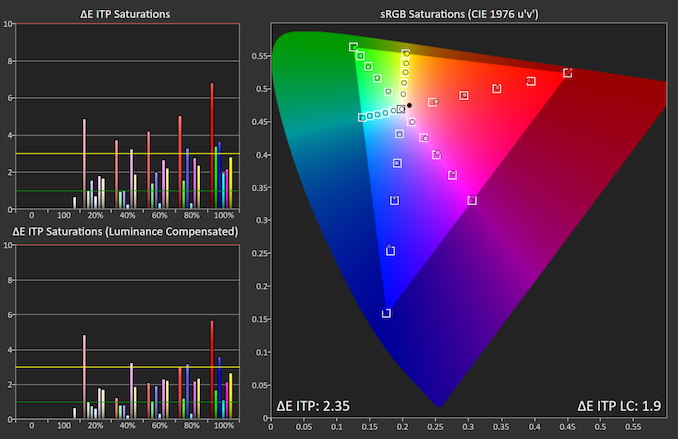 Portrait Displays CalMAN
Portrait Displays CalMAN
Galaxy S21
The smaller S21 doesn’t have the same issue, showcasing generally more accurate colours.

 Portrait Displays CalMAN
Portrait Displays CalMAN
Galaxy S21 Ultra
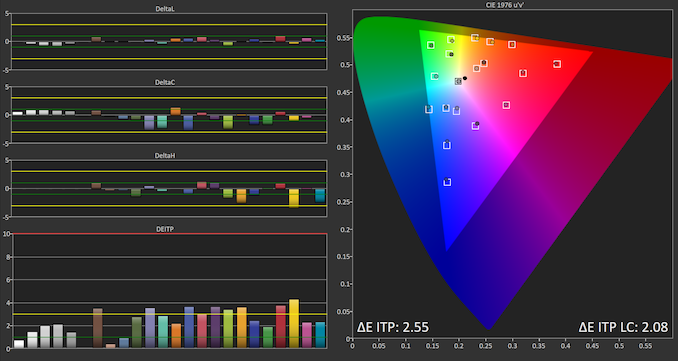
 Portrait Displays CalMAN
Portrait Displays CalMAN
Galaxy S21
Gretag MacBeth test patches with common colours such as skin tones fare well for both the S21 Ultra as well as the S21, although the latter does better, showcasing less luminosity errors.
Overall, Samsung did uncharacteristically well this year when it comes to colour accuracy. After a few years of glaring gamma issues and too warm whites, the S21 series seems to be able to achieve great results out of the box, early on in its firmware, which couldn’t be said of the S10 or S20 series.
The S21 Ultra’s display in terms of its fundamentals is outstanding – it gets extremely bright, more than any other phone in the market right now. Together with the 1440p resolution and 120Hz refresh rate, it represents the single best mobile display in the industry right now.
The smaller S21 display is good, although really not in the same class as the Ultra’s panel. There’s really nothing much to write home about here, as it’s very much similar to many other 1080p panels in the industry, with good brightness levels, good colour accuracy, and of course also featuring that 120Hz adaptive refresh rate mode. If the Ultra’s panel is an S-tier display, the baseline model’s display is A-tier.


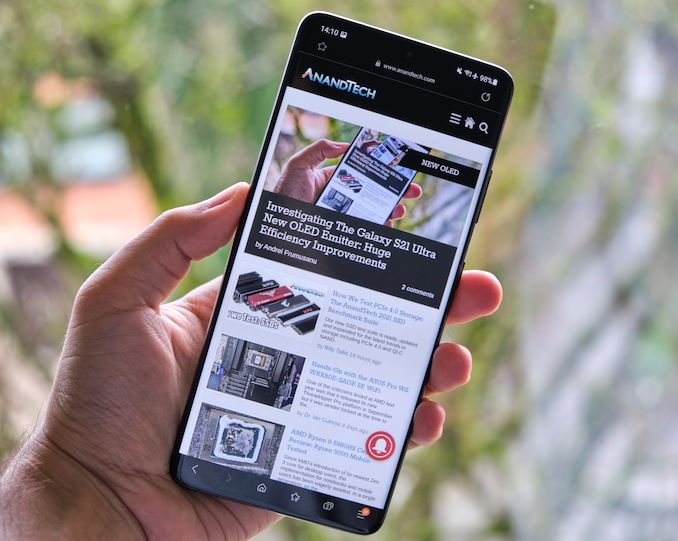








122 Comments
View All Comments
TwoMetreBill - Monday, February 22, 2021 - link
Until we can see the results of the raw images processed in something like Lightroom, we won't really know what we can get from this system. The smaller the sensor, as a general rule, the greater the improvement from raw shooting. But as far as I can tell, nobody has published a raw sample library and I search every day.s.yu - Wednesday, February 24, 2021 - link
Just get a compatible version of Gcam running. With SD Samsung it's the easiest to find.tkSteveFOX - Tuesday, February 23, 2021 - link
Again, Huawei's Kirin 9000 knocks it out of the park. A better chip all-round.Samsung's 5nm is not even as good or roughly on par with TSMCs 7nm.
Getting an SD870 looks like a better deal this year, but if Huawei manage to produce a $800 Kirin 9000 device that would be the best of the best.
I am amazed how their massive GPU doesn't throttle as much as both Adreno 660 and MP14 in the E2100.
iphonebestgamephone - Tuesday, February 23, 2021 - link
Maybe being slow and wide is the best?s.yu - Wednesday, February 24, 2021 - link
The guy wasn't paying attention. The Adreno throttled far more than it was supposed to with the whole SoC settling down at 3W when it should have nearly 5W to use. And in several benchmarks the Kirin wasn't that fast either, so he's completely confused.And yes slow and wide has always been better but that only applies to the Mali comparison.
iphonebestgamephone - Thursday, February 25, 2021 - link
Yeah the sd samsung seems to throttle too much, while the mi 11 doesnt want to throttle.yeeeeman - Tuesday, February 23, 2021 - link
underwhelming. on the system performance page we can clearly see the s20 ultra w/ sd 865 being barely slower and you say the performance is outstanding. Sure, it is outstanding, but it isn't an improvement over the last gen. Battery life, again, similar. the only improvement is the gpu and the display efficiency.s.yu - Wednesday, February 24, 2021 - link
I have to agree.flyingpants265 - Friday, February 26, 2021 - link
Slower? The speed is not going to matter for 99% of users so I'm not sure what you're talking about there. Who cares?The Android OS and software suck so bad. We've had 14 generations of laggy phones now..
iphonebestgamephone - Saturday, February 27, 2021 - link
”The Android OS and software suck so bad. We've had 14 generations of laggy phones now..”So what they care about is lag? Half a second of stutter is what they care more about, than the general speed?